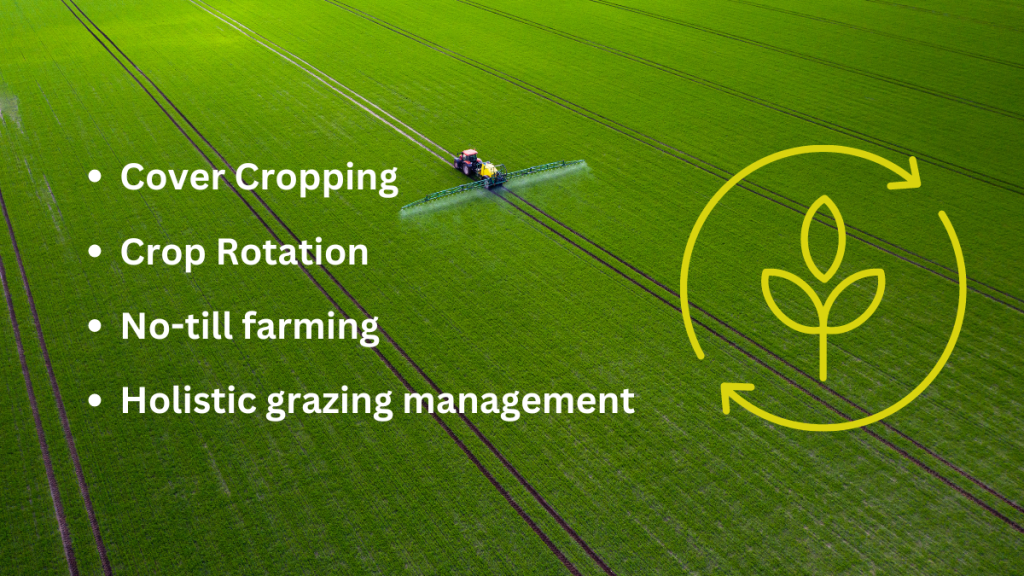As the global agricultural system faces growing challenges—from soil degradation to biodiversity loss and climate change—regenerative agriculture is emerging as a promising solution.
This eco-friendly approach not only enhances soil health and biodiversity but also contributes to climate change mitigation by sequestering carbon and reducing greenhouse gas emissions.
In this article, we’ll explore the benefits of regenerative agriculture and offer practical tips for farmers interested in making the transition.
Regenerative Agriculture
Regenerative agriculture is a holistic farming approach that prioritizes the regeneration of the soil and ecosystems while also providing for human needs.
Unlike conventional farming methods, which often rely on chemical inputs and can deplete the soil and degrade ecosystems, regenerative practices restore soil vitality, promote biodiversity, and reduce dependency on synthetic fertilizers and pesticides.
Key Regenerative Practices

Cover Cropping: Planting crops like clover or legumes to cover the soil year-round, preventing erosion and increasing organic matter.
Crop Rotation: Changing the types of crops grown in a field to improve soil fertility and break pest cycles.
No-till Farming: Minimizing soil disturbance to preserve its structure and carbon content.
Holistic Grazing Management: Allowing livestock to graze in ways that mimic natural patterns, promoting soil health and reducing erosion.
Soil Health: The Foundation of Regenerative Agriculture
Healthy soil is the cornerstone of sustainable farming.
Conventional agricultural practices, such as monocropping and excessive tillage, often strip soils of nutrients, leading to erosion and a loss of organic matter.
Regenerative agriculture, however, focuses on replenishing and maintaining soil health through organic matter inputs, such as compost, cover crops, and animal manure.
Benefits for soil health

Increased organic matter and fertility
Practices like cover cropping and composting add organic matter to the soil, improving its structure and water retention capabilities.
Erosion prevention
By keeping soil covered year-round and reducing tillage, regenerative agriculture prevents erosion, especially in vulnerable areas like slopes.
Enhanced water infiltration
Healthier soils absorb and retain more water, reducing runoff and improving drought resilience.
Example: Gabe Brown’s Farm in North Dakota
Gabe Brown, a pioneer of regenerative agriculture, transformed his North Dakota farm by focusing on soil health.
Through no-till practices, cover cropping, and holistic grazing, he restored his soil’s fertility, increased crop yields, and significantly reduced input costs.
His farm now thrives without synthetic fertilizers or pesticides, proving the economic and environmental benefits of regenerative farming.
Biodiversity: Supporting Resilient Ecosystems
Biodiversity plays a critical role in ecosystem resilience.
Traditional farming methods, especially monocultures, reduce biodiversity by planting the same crop year after year.
Regenerative agriculture, by contrast, encourages polycultures—diverse crops and animals that work in harmony.
Benefits for biodiversity
Support for pollinators
Diverse crop rotations and cover crops provide habitats for pollinators like bees and butterflies, which are essential for the reproduction of many plants.
Soil microbial diversity
Healthy, undisturbed soils are rich in microorganisms that support plant growth, nutrient cycling, and disease resistance using Nutrient Management.
Wildlife habitat creation
Farms that include buffer zones, agroforestry, and mixed-species plantings provide shelter and food for birds, insects, and mammals.

Example: The Savory Institute’s Land-to-Market Program
The Savory Institute, a global leader in regenerative agriculture, works with farmers worldwide to enhance biodiversity through holistic management of land and livestock.
Their Land-to-Market program certifies farms that use regenerative practices, demonstrating how livestock can restore grasslands, improve soil health, and boost biodiversity.
Climate Change Mitigation: Agriculture as a Carbon Sink
Agriculture has traditionally been a contributor to greenhouse gas emissions, but regenerative agriculture flips this narrative by making farms part of the solution.
Through practices that build organic matter and minimize disturbance, regenerative farming sequesters carbon in the soil, effectively turning farmland into a carbon sink.
Benefits of Climate Change Mitigation
Carbon sequestration
Increasing soil organic matter helps capture carbon from the atmosphere and store it in the ground.
Some studies estimate that regenerative practices could sequester up to 1.2 gigatons of carbon annually.
Reduced emissions
By eliminating synthetic fertilizers and pesticides, regenerative farmers reduce the fossil fuel emissions associated with their production and use.
Resilience to climate extremes
Healthier soils are better able to withstand the effects of droughts, floods, and other extreme weather events associated with climate change.
Example: White Oak Pastures in Georgia
White Oak Pastures, a regenerative farm in Georgia, has been recognized for its efforts in carbon sequestration.
Their holistic grazing practices enhance soil carbon levels and biodiversity while supporting the local economy.
According to a life-cycle assessment, the farm offsets more carbon than it emits, making it a rare example of carbon-negative agriculture.
Practical Tips for Farmers Transitioning to Regenerative Agriculture

For farmers interested in transitioning to regenerative agriculture, here are some practical tips to get started:
Start small
Begin with cover crops or no-till on a portion of your land to see how it impacts soil health and yields.
Incorporate livestock
Consider adding livestock or integrating rotational grazing to boost soil fertility and ecosystem health.
Diversify your crops
If you currently practice monocropping, start incorporating a diverse range of crops to improve soil fertility and pest resistance.
Reduce synthetic inputs
Gradually reduce your use of synthetic fertilizers and pesticides as your soil becomes healthier and more resilient.
Partner with regenerative networks
Join a regenerative agriculture network like the Savory Institute or Regen Network to learn from others and share knowledge.
Conclusion
Regenerative agriculture is not just a farming method—it’s a pathway to a more sustainable and resilient food system.
By focusing on soil health, biodiversity, and climate change mitigation, regenerative practices offer tangible benefits for farmers, ecosystems, and the planet.
As more farms adopt these techniques, we move closer to an agricultural system that restores rather than depletes the earth’s resources.
For farmers looking to make the transition, the journey starts with small steps—whether through cover cropping, reducing tillage, or diversifying crops.
With the right support and dedication, regenerative agriculture can help pave the way for a healthier, more sustainable future for farming.
Know more about the Regenerative Agriculture Mindset.
Learn about the Ethical Implications of Genetic Engineering in Agriculture.

